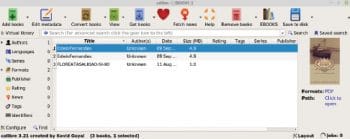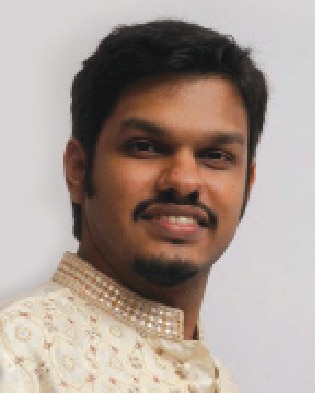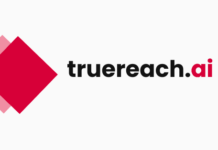If you search for ‘calibre’ online, you will get information related to the e-book management software. The word ‘calibre’ means many things in the English language — it means one thing to musicians, and quite another to a gun owner. It is also the name of a movie. So, it’s interesting that the calibre software shows up before the rest.
Wikipedia also ranks calibre (the software) on top of its lists. Its entry makes it clear that this is a potent software that is well recognised by users worldwide.
Writing in another context, Erez Zukerman said on makeuseof.com: “Much has been written about this fantastic free application [calibre e-book manager], and we have an entire manual dedicated to it, titled, ‘Open Book: Managing Your eBooks With Calibre’.” (Check out the links under References.) The first release of this software was over 13 years ago.
It might seem a bit strange that Indians are barely aware that this excellent software, which so many around the world use, has been created by a desi.
So the first question I, almost accusingly, asked Kovid Goyal was, “I am hugely impressed by what calibre has accomplished. How come so few recognise that this product has been made by an Indian (or at least, led by one)?”
Kovid shot back: “I don’t know. I don’t advertise the fact that I am Indian, I guess.”
Calibre (spelt as calibre, without a capital letter) has, or is, being translated into about 106 languages worldwide. Spanish and Ukrainian translations are both 100 per cent complete. Other languages include French (99.9 per cent), Swedish (96.4 per cent), German (86.3 per cent), Zulu and Xhosa (barely 0.3 per cent complete, but at least it’s being done), besides many more.
Attempts are being made, with varying degrees of success, to translate it into Telugu, Sinhala, Pushto, Malayalam, Bengali, Hindi (only 3.2 per cent complete), Gujarati, Kannada (34.1 per cent), Tamil (38.9 per cent), Punjabi (38.2 per cent) and Marathi (39.3 per cent), among the languages of South Asia.

So how did it all start?
Let’s hear the story in Goyal’s words: “calibre started life on October 31, 2006, soon after the release of the Sony PRS-500, the first e-ink based reader to be sold commercially in the US.”
At the time, Goyal was a graduate student with a lot of time on his hands. And, the PRS-500 did not work at all with GNU/Linux, his operating system of choice. So he decided to reverse engineer the USB protocol that it used, to get it working on FOSS (free and open source software).
“This was accomplished with the help of the fine folks over at mobileread.com and calibre was born, albeit named libprs500. Since libprs500 seemed to have a fair number of fans, I decided to put up a small ‘Donate’ button on its website,” Goyal told OpenSource magazine in an interview.
And then what?
Goyal continues reminiscing, “In the initial stages, it created enough income for me to afford one pizza a week, which was very welcome as a grad student. As the book phenomenon took off, that income grew and libprs500 usage also started shooting through the roof.”
Wow!
So Goyal began to seriously consider doing this on a full-time basis. It was when he returned home to India — he’s based in Mumbai — to get married, that he renamed libprs500 to calibre and decided to “get more serious about doing it full time.”
“It was still very much a leap into the unknown for me, as I had always envisaged a career as an academic before then. But, with the support of my wife and with my fingers very much crossed, after graduating, I took the plunge and have never looked back since. The calibre community has supported me working on it full time, ever since,” he told this magazine, with a clear sense of accomplishment.
So, what would he rate as calibre’s unique contribution to the brave new world of e-books, a phenomenon which is hardly over a decade old?
“Most of calibre’s major features are unique to it,” Kovid points out. calibre is described as “a powerful and easy-to-use e-book manager.” It’s a tool that will “allow you to do nearly everything and it takes things a step beyond normal e-book software. It’s also completely free and open source, and great for both casual users and computer experts.”
It promises a lot — saving of time while managing your e-book collection, the ability to “use it everywhere and with anything,” a comprehensive e-book viewer, the possibility to download news and magazines from the Web, the option to back up and share your library easily, and a chance to even edit books in your collection. Along with all this comes the bonus of support.
With its versatile nature, calibre allows you to do a lot of thing with your e-books. You can sort and group e-books by their metadata fields. Metadata (which is used to identify e-books) can be ‘pulled’ in from different book related sources, online. It is possible to search a calibre library using various fields — author, title or keywords.
You can ‘sideload’ e-books into your calibre library, or wirelessly sync your cloud storage service with an e-book reading device. Online content-sources can be ‘harvested’ and converted into e-books. There are also ‘recipes’, which are small programs written in Python-based, domain-specific languages.
In reply to a query, Goyal says: “calibre has no significant competitors. Most other e-book management software is tied to some proprietary e-book ecosystem or the other. And because calibre, being free and open source, dominated this space right from the beginning, it has no non-proprietary competition.”

Usage statistics of calibre show that its top users are in Spain, the US, Germany, China and France. India, with a mere 1.6 per cent share of all users worldwide, stands at a fairly poor 15th position. Come on guys, we could do better.
“The places with the most calibre usage are those with the most mature e-book ecosystems/markets,” says Goyal.
So what was the toughest part of creating this product? “Dealing with trolls,” Goyal replies. “Creating anything in the Internet age, involves growing a very thick skin,” he adds.
Commenting on calibre a decade ago, on November 2009, Kovid Goyal had called it a project with “a vibrant open source community with half a dozen developers and many, many testers and bug reporters.” Today’s list of contributors to the project is very international.
Goyal looks back with justifiable pride, saying, “It is used in over 200 countries and has been translated into a dozen different languages by volunteers. calibre has become a comprehensive tool for the management of digital texts, allowing you to do whatever you could possibly imagine with your e-book library.”
E-books are digital books, consisting of texts and images. They can be delivered to you immediately on purchase. India is still to significantly pick up on e-book reading, but this is seen as one possible technology of the future.
calibre is written in Python, JavaScript, C++ and C. It works on GNU/Linux, Windows and the macOS operating systems. Its current stable version is 4.2 [1], released on October 18, 2019. The software’s size is around 60MB.
By now, this e-book reader has diverse apps associated with it — Calibre Cloud, Calibre Sync, Calibre-go (all free of charge); and Calibre Cloud Pro, Calibre Companion, Calibre Library (all paid). CalibreBox comes with both free and paid versions.
Goyal acknowledges that reading is very important to him and “one of my goals has always been to prevent either the fragmentation or the monopolisation of the e-book market by entities that care solely for short term goals.” Wonder what the Amazons of the world think of this Indian’s approach.
As the calibre community continues to grow, driven by book lovers for book lovers, hopefully it will always present an alternative for people who love to read e-books and want to be in control of their own digital libraries, Goyal adds.
I asked him whether he feels enough Indians contribute to FOSS creation. “No,” Goyal says. “India has a very limited presence in open source. The main reason for this is probably because most Indians who create software simply do it to make money, and not for the love of the subject. I’m sure that will change with time as Indian society as a whole gets more affluent,” he adds.
calibre’s evolution is entirely user driven, says Goyal, so new features come about as they are requested for, by the community. He adds: “My immediate plans are to revamp certain internals of calibre to deal with changes in the underlying tech stacks.”
When asked for a bio-data, Goyal tells me without irony, “I don’t have a CV, I’m afraid, as I have never wanted to be employed. In brief, I graduated from Caltech with a PhD in Quantum Information Theory and have been working full time on calibre ever since (about 12 years now).” By way of background, Goyal went to Jamnabai Narsee School, did junior college at D.G. Ruparel and his undergrad at St Xavier’s in Mumbai.
He adds: “I’m not very involved with FOSS movements, I just write FOSS software.” A pity… India’s young people could sure do with more role models.
Looking forward to more Kovid Goyals anyway….
















































































